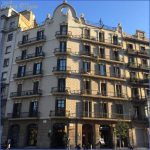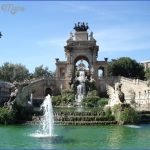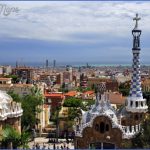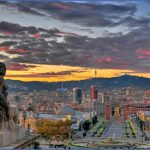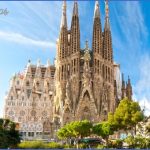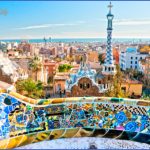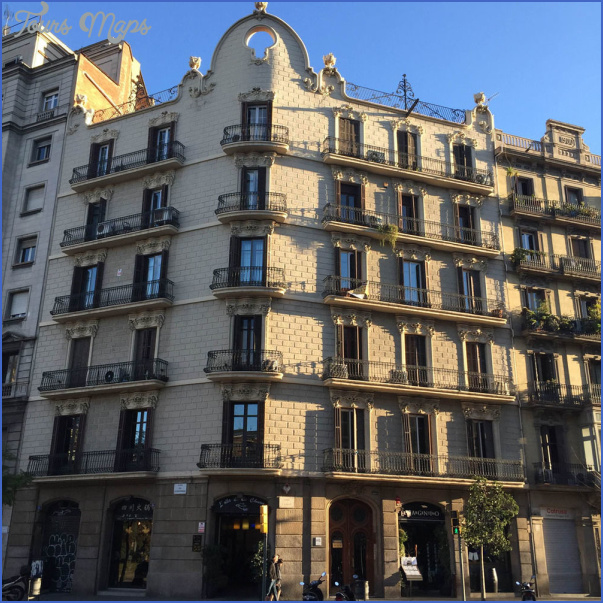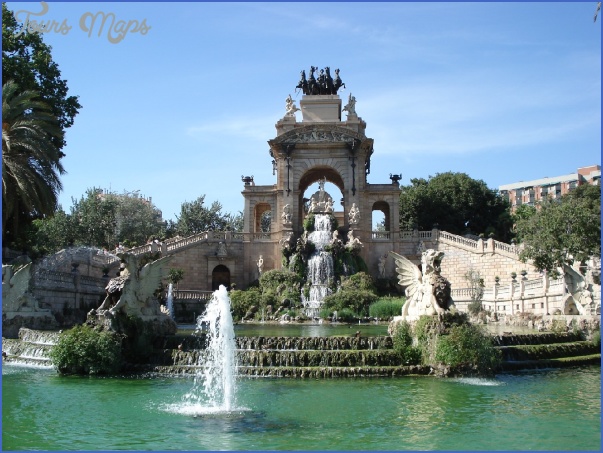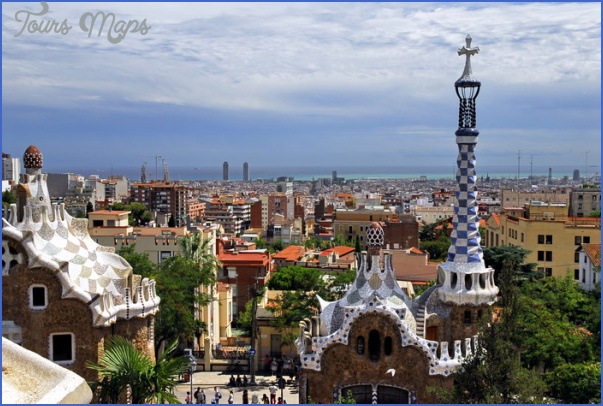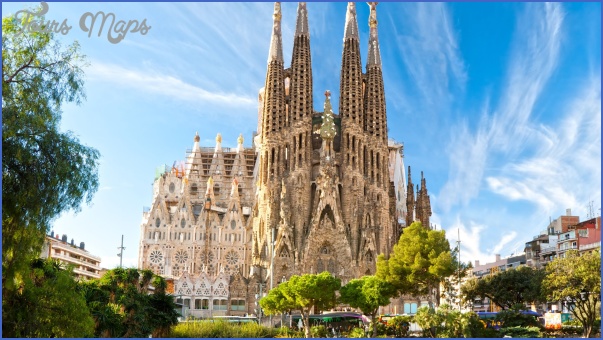PALAU GUELL. Gaudf’s Palau Gttell (1886) the Modernist residence built for patron Eusebi Gttell (of Park Gttell fame) has one of Barcelona’s most spectacular interiors. Gttell spared no expense on this house, considered to be the first where Gaudfs unique style truly showed. (C. Nou de La Rambla 3-5. M: Liceu. Open Mar.-Oct. Su 10am-2pm, M-Sa 10am-8pm, last tour at 6:15pm; Nov.-Dee. M-Sa 10am-6pm. ‚3, students ‚1.50. Mandatory tour every 15min.)
MUSEU D’ART CONTEMPORANI (MACBA). This monstrosity of a building was constructed with the idea that sparse decor would allow the art to speak for itself. The MACBA has received worldwide acclaim for its focus on avant-garde art between the two world wars, as well as Surrealist and contemporary art. (PI. dels Angels 1. M: Catalunya. Open July-Sept. M, W, and F1 lam-8pm; Th 1 lam-9:30pm; Sa 10am-8pm: Su 10am-3pm. Oct.-June M and W-F Uam-7:30pm, Sa 10am-8pm, Su 10am-3pm. ‚7, students ‚3. Under-17 free.)
FAR-OUT FACADE Gaudi was a religious man, and his plans for La Sagrada Familia called for elaborate and deliberate symbolism in almost every single decorative element of the church. The cypress tree on the Nativity Facade, according to one theory, symbolizes the stairway to heaven (cypress trees do not put down deeper roots with time but only grow increasingly taller); the tree is crowned with the word Tau,the Greek word for God. Similarly, the top of each of the eight finished towers carries the first letter of one of the names of the apostles (and the words Hosanna and Excelsis are written in a spiral up the sides of the towers). Inside, on the Portal of the Rosary, overt references to modern life lurk amongst more traditional religious imagery; the Temptation of Man is represented in one carving by the devil handing a bomb to a terrorist and in another by his waving a purse at a prostitute.
Suberachs, Gaudi’s successor, continued the religious symbolism in his Passion Facade. To the left, a snake lurks behind Judas, symbolizing the disciple’s betrayal of Jesus. The 4×4 box of numbers next to Him contains 310 possible combinations of four numbers, each of which adds up to 33, Christ’s age when He died. The faceless woman in the center of the facade, Veronica, represents the Biblical woman with the same name and the miraculous appearance of Christ’s face on the cloth with which she compassionately wiped his face.
CENTRE DE CULTURA CONTEMPORANIA DE BARCELONA (CCCB). The center stands out for its mixture of architectural styles, consisting of an early 20th-century theater and its 1994 addition, a sleek wing of black glass. The institute shows a variety of temporary exhibits, including film screenings and music performances; check the Guia del Ocio for scheduled events. (Casa de Caritat. C. Monta-legre 5. M: Catalunya or Universitat. s933 06 41 00. Open Tu, Th, and Fllam-2pm and 48pm; WandSa llam-8pm; Su and holidays llam-7pm. ‚4, students ‚3, W ‚3 for all. Children free.)
L’EIXAMPLE
The Catalan Renaissance and the growth of Barcelona during the 19th century pushed the city past its medieval walls and into modernity. Ildefons Cerda drew up a plan for a new neighborhood where people of all social classes could live side by side; however, l’Eixample (pronounced luh-SHOMP-luh) did not thrive as a utopian community but rather as a playground for the bourgeois. Despite the gentrifi-cation, the original Modernist architecture remains truly idealistic.
LA SAGRADA FAMlLIA. Although Antoni Gaudi’s unfinished masterpiece is barely a shell of the intended finished product, La Sagrada Familia is without a doubt the world’s most visited construction site. Despite the fact that only eight of the eighteen planned towers have been completed (and those the shortest, at that) and the church still doesn’t have an interior, millions of people make the touristic pilgrimage to witness its work-in-progress majesty. Of the three proposed facades, only the Nativity Facade was finished under Gaudi. A furor has arisen over recent additions, especially sculptor Josep Subirachs’s Cubist Passion Facade, which is criticized for being inconsistent with Gaudi’s plans. (C. Mallorca 401. M: Sagrada Familia. Open Apr.-Sept. daily 9am-8pm, elevator open 9;30am-7:45pm; Oct.-Mar. 9am-6pm, elevator open 9:30am-5:45pm. Entrance ‚8, students ‚5. Cash only. H Guided tours Apr.-Sept. daily every hour Uam-5pm; Oct. 1 lam-3pm; Nov.-Mar. Su-M and FSa 1 lam-lpm. ‚3.)
LA MANZANA DE LA DISCORDIA. A short walk from PI. Catalunya, the odd-numbered side of Pg. de Gracia between C. Arago and Consell de Cent is popularly known as la manzana de la discdrdia (block of discord), referring to the
stylistic clashing of three buildings. Regrettably, the bottom two floors of Casa Lleo i Morera, by Domenech i Montaner, were destroyed to make room for a fancy store, but you can buy the Ruta del Modernisme pass there and take a short tour of the upper floors, where sprouting flowers, stained glass, and legendary doorway sculptures adorn the interior. Puig i Cadafalch opted for a geometric, Moorish-influenced pattern on the facade of Casa Amatller at #41. Gaudi’s balconies ripple like water, and tiles sparkle in blue-purple glory on Casa Batllti, #43. The most popular interpretation of Casa Batllo is that the building represents Cataluna’s patron Sant Jordi (St. George) slaying a dragon; the chimney plays the lance, the scaly roof is the dragon’s back, and the bony balconies are the remains of his victims. (Open M-Sa 9am-2pm, Su 9am-8pm. ‚8, students ‚6.)
HCASA MILA (LA PEDRERA). Modernism buffs argue that the spectacular Casa Mila apartment building, an undulating mass of granite popularly known as La Pedrera (the Stone Quarry), is Gaudi’s most refined work. Note the intricate ironwork around the balconies and the irregularity of the front gate’s egg-shaped window panes. The roof sprouts chimneys that resemble armored soldiers, one of which is decorated with broken champagne bottles. Rooftop tours provide a closer look at these Prussian helmets. The winding brick attic has been transformed into the Espai Gaudi, a multimedia presentation of Gaudi’s life and works. (Pg. Gracia 92. Open daily 10am-8pm. ‚7; students and over-65 ‚3.50. Free guided tours in English M-F 4pm, Sa-Su 11am.)
HOSPITAL DE LA SANTA CREU I SANT PAU. Designated a UNESCO monument in 1997, the brilliant Modernist Hospital de la Santa Creu i Sant Pau was Domenech i Montaner’s lifetime masterpiece. The entire complex covers nine full l’Eixample blocks (320 acres) and the pavilions are whimsically decorated, resembling gingerbread houses. The outdoor spaces are an oasis in the desert of urban gridding; they once included a small forest and still boast more than 300 different types of plants, as well as plenty of shaded paths. (Sant Antoni M. Claret 167. M: Hospital de St. Pau, L5. nr934 88 20 78. Hospital grounds open 24hr. 50min. guided tours Sa-Su every 30min 10am-2pm. Last tour leaves 1:30pm. ‚4.30, students and over-65 ‚3.)
FUNDACIO ANTONI TAPIES. Antoni Tapies is one of Cataluna’s best-known artists; his works often defy definition, springing from Surrealism and Magi-cism. Tapies’s massive and bizarre wire sculpture (Cloud with Chair) atop Domenech i Montaner’s red brick building announces this collection of contemporary abstract art. The top floor of the foundation is dedicated to famous Catalans, particularly Tapies, while the other two floors feature temporary exhibits of other modern artists’ work. (C. Arag6 255. M: Pg. de Gr’acia. s934 87 03 15. Museum open Su and Tu-Sa 10am-8pm. ‚4.20, students and seniors ‚2.10.)
Barcelona Travel Photo Gallery
Maybe You Like Them Too
- Explore Pulau Sebang Malaysia with this Detailed Map
- Explore Southgate, Michigan with this detailed map
- Explore Les Accates, France with this Detailed Map
- Explore Góra Kalwaria, Poland with this detailed map
- Explore Gumdag, Turkmenistan with this detailed map

